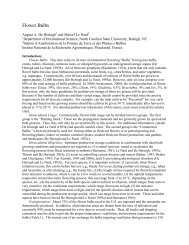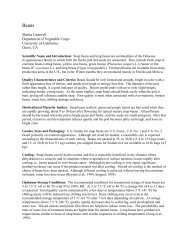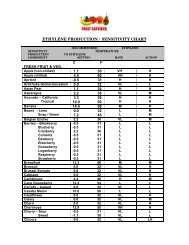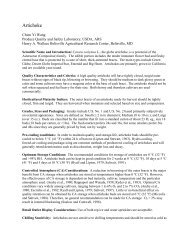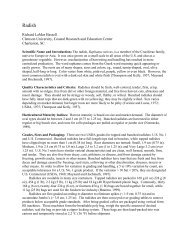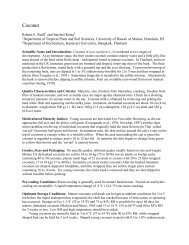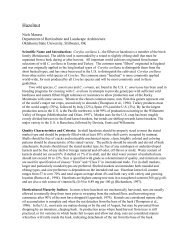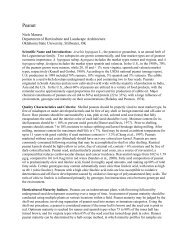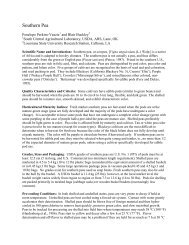Bok Choy
Bok Choy
Bok Choy
You also want an ePaper? Increase the reach of your titles
YUMPU automatically turns print PDFs into web optimized ePapers that Google loves.
<strong>Bok</strong> <strong>Choy</strong><br />
Yaguang Luo<br />
Produce Quality and Safety Laboratory, USDA/ARS<br />
Henry A. Wallace Beltsville Agricultural Research Center, Beltsville, MD<br />
Scientific Name and Introduction: <strong>Bok</strong> choy (Brassica campestris L. ssp chinensis) is also known as<br />
Chinese chard, boy-toyo, pak-choy, and pak-tsoi (King, 1989). <strong>Bok</strong> choy is the non-heading type of<br />
Chinese cabbage (Li, 1981). It is annual of the Cruciferae family. The edible portions are the shinny,<br />
dark green leaves and the thick, chalk-white stalks (Peirce, 1987). Most U.S. bok choy is produced in<br />
California.<br />
Quality Characteristics and Maturity Indices: High quality bok choy has thick, fleshy, firm stalks and<br />
glossy, dark-green leaves. <strong>Bok</strong> choy with bruised or slimy spots and wilted leaves should be avoided.<br />
Grades, Sizes and Packaging: <strong>Bok</strong> choy is mainly supplied to ethnic markets in the U.S., but many large<br />
supermarkets are carrying it in their ‘ethnic’ fresh produce departments. There are no standard U.S.<br />
grades.<br />
Pre-cooling conditions: Prompt pre-cooling to near 0 °C (32 °F) is important to maintain freshness and<br />
for extended storage.<br />
Optimum Storage Conditions: The recommended storage conditions for bok choy are 0 to 5 °C (32 to<br />
41 °F) with > 95% RH.<br />
Controlled Atmosphere (CA) Considerations: Low O 2 atmospheres of 0.5 to 1.5% retard leaf<br />
yellowing caused by chlorophyll degradation (O’Hare et al., 1995). A combination of 5% CO 2 + 3% O 2<br />
delay leaf yellowing and senescence during storage (Wang and Herner, 1989).<br />
Retail Outlet Display Considerations: <strong>Bok</strong> choy is displayed loosely on a refrigerated shelf. Misting<br />
should be applied to minimize moisture loss and desiccation.<br />
Chilling Sensitivity: <strong>Bok</strong> choy is not chilling sensitive and should be stored as cold as possible without<br />
freezing. It freezes at -0.5 °C (31.1 °F).<br />
Ethylene Production and Sensitivity: <strong>Bok</strong> choy produces very small amounts of ethylene at 0.1 to 0.2<br />
µL kg -1 h -1 and is not overly sensitive to ethylene.<br />
Respiration Rates:<br />
Temperature mg CO 2 kg -1 h -1<br />
0 °C 5 to 6<br />
5 ° C 10 to 12<br />
10 °C 19 to 21<br />
15 °C 34 to 44<br />
20 °C 48 to 63<br />
To get mL kg -1 h -1 , divide the mg kg -1 h -1 rate by 2.0 at 0 °C (32 °F), 1.9 at 10 °C (50 °F), and 1.8 at 20 °C<br />
(68 °F). To calculate heat production, multiply mg kg -1 h -1 by 220 to get BTU per ton per day or by 61 to<br />
get kcal per metric ton per day. Data are from Luo and Zheng, 2001.
Physiological Disorders and Postharvest Pathology: Leaf yellowing is a sign that senescence has<br />
occurred during extended storage, or under high than optimal storage temperatures. Storing bok choy at 0<br />
to 5 °C (32 to 41 °F) will mitigate this problem.<br />
Quarantine Issues: None.<br />
Suitability as Fresh-cut Product: No current potential.<br />
References:<br />
King, J. 1989. Consumers learning new names: bok choy to jicama. Farmline, USDA, Econ. Res. Serv.,<br />
Washington DC, Vol. 10, pp. 11-13.<br />
Li, C.W. 1981. The origin, evolution, taxonomy and hybridization of Chinese cabbage. In: N.S. Talekar<br />
and T.D. Griggs (ed) Chinese Cabbage. Hong Wen Printing Works, Tainan, pp. 1-10.<br />
Li, C.W. 1984. Chinese cabbage. Chung-kuo ti pai ts’ai. Pei-ching: Nung yeh ch’u pan she: Hsin hua shu<br />
tien Pei-ching fa hsing so fa hsing. (In Chinese)<br />
Luo, Y. and Y. Zheng. 2001. Respiration rate and ethylene production of bok choy at different<br />
temperature regime. (unpublished data).<br />
O’Hare, T.J, L.G. Smith, L.S. Wong and G.F. Meiburg. 1995. Low-oxygen storage of whole and<br />
minimally processed pak choi. Australasian Postharv. Hort. Conf., pp. 459-462.<br />
Peirce, L.C. 1987. Vegetables - characteristics, production, and marketing. John Wiley and Sons, pp. 224-<br />
227.<br />
Wang, H. and R.C. Herner. 1989. Effect of CA storage on the ultrastructure of chloroplasts and<br />
chlorophyll content of Chinese mustard. Proc. 5th Intl. Contr. Atmos. Res. Conf., Wenatchee WA,<br />
2:9-17.



